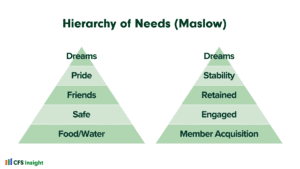Every credit union has heard some variation of the following pitch from a vendor.
“We have a near-perfect member attrition model that is 94.3% accurate. You will know before they close their account and will have a short list of only the highest risk members.”
While member attrition models are useful in identifying members who are at high risk of leaving, they only serve as a starting point for improving customer retention and member retention rates. Customer attrition models have been around for decades. AT&T perfected the method, and all the major consulting firms propagated it. However, simply having an attrition model in place does not guarantee that a credit union will retain its members.
So why doesn’t every bank, credit union, grocery store, etc., have an army of anti-attrition people? Because simply identifying at-risk members is not enough to improve customer retention rates.
Let’s walk through what happens once this member attrition model is implemented at the credit union and see what happens next.
Member Attrition Process
You have your shiny new attrition model installed. You have spent the last three months watching the predictions and seeing how the model performs. As advertised, 90% of the members predicted to leave are leaving the CU.
Now you are ready to get in front of these members and save them. You have a few folks from retail that you have asked to call the members on this attrition report. Your team makes 100’s of calls. Your efforts only manage to save a few members that are predicted to leave. And the few you saved ended up leaving within a year. What just happened? How could it be so accurate and so wrong at the same time?
It’s the Deposits
When you look at deposits, you will notice certain patterns for your members. There are lots of different deposit patterns like:
- Every Friday
- Every Tuesday
- The 1st and the 15th
- The 1st
- Every 3rd Friday
- And so on
While there are a lot of different patterns, members tend to keep the same pattern over a long period of time. It is incredibly rare to see a member with a genuinely erratic deposit pattern, especially if they are not business owners.
Most attrition models look at these deposit patterns and flag a member if they miss one of their expected deposits. This makes a lot of sense because if they miss their deposit, there is probably an issue.
But, we need to see this from the member’s perspective. It takes time and effort for the member to move a deposit, especially a repeating deposit, to another institution. It could take weeks, if not months, for them to make the decision, fill out the paperwork, and for the missed deposit to happen. By the time your anti-attrition staff calls the member, they could be two or more months from their decision to leave.
At this point, there has been ample time for the momentum to already be with the new institution. It is almost impossible to bring a member back from this point. So, while the model is very ‘accurate,’ it doesn’t provide the CU with the desired outcome of not only keeping the member but making sure they are engaged as possible.
Alternative
What are the alternatives if member attrition models don’t create the desired outcome? The answer lies in looking at members who stay for five, ten, fifteen years, or more and improving their customer retention rates. Specifically, by looking at their transactions, you can get a real-time view of their engagement. This is a much richer data set when compared to product data, which can be very old.
CFS Insight has created a model that is able to define which members are at the highest level of engagement and expose which members can be nudged into higher retention categories. This has two benefits; the member will stay with the CU for longer, but also, they generate much higher member retention rates of interchange income.
Please find more information here
Conclusion
If the CU only wants to get an accurate churn metric, member attrition models can be helpful. If the desired outcome is to keep more of your members and move them closer to the top of wallet, then a member retention model is a better option.
From Churn to Loyalty
Winning the Battle for Member Retention in Credit Unions
Member retention is critical, yet finding effective solutions and measuring positive outcomes remains a challenge. In this whitepaper, we aim to delve into the complexities surrounding these issues and propose alternative approaches that credit unions can adopt to achieve better results. Complete the form below to get access to the whitepaper.





